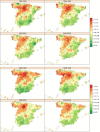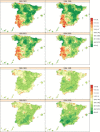Time trends in municipal distribution patterns of cancer mortality in Spain
- PMID: 25060700
- PMCID: PMC4124154
- DOI: 10.1186/1471-2407-14-535
Time trends in municipal distribution patterns of cancer mortality in Spain
Abstract
Background: New disease mapping techniques widely used in small-area studies enable disease distribution patterns to be identified and have become extremely popular in the field of public health. This paper reports on trends in the geographical mortality patterns of the most frequent cancers in Spain, over a period of 20 years.
Methods: We studied the municipal spatial pattern of stomach, colorectal, lung, breast, prostate and urinary bladder cancer mortality in Spain across four quinquennia, spanning the period 1989-2008. Case data were broken down by town (8073 municipalities), period and sex. Expected cases for each town were calculated using reference rates for each five-year period. For map plotting purposes, smoothed municipal relative risks were calculated using the conditional autoregressive model proposed by Besag, York and Mollié, with independent data for each quinquennium. We evaluated the presence of spatial patterns in maps on the basis of models, calculating the variance in relative risk corresponding to the structured spatial component and the unstructured component, as well as the proportion of variance explained by the structured spatial component.
Results: The mortality patterns observed for stomach, colorectal and lung cancer were maintained over the 20 years covered by the study. Prostate cancer and the tumours studied in women showed no defined spatial pattern, with the single exception of stomach cancer. The trend in spatial fractional variance indicated the possibility of a change in the spatial pattern in breast, bladder and colorectal cancer in women during the last five-year period. The paper goes on to discuss ways in which spatio-temporal data are depicted in the case of cancer, and review the risk factors that may possibly influence the respective tumours' spatial patterns.
Conclusion: In men, the marked geographical patterns of stomach, colorectal, lung and bladder cancer remained stable over time. Breast, colorectal and bladder cancer in women show signs of the possible appearance of a spatial pattern in Spain and should therefore be monitored.
Figures






References
-
- Lawson A, Biggeri A, Bohning D, Lesaffre E, Biggeri A, Viel JF, Best N. Disease Mapping and Risk Assessment for Public Health. Chichester: Wiley; 1999.
-
- López-Abente G, Ramis R, Pollán M, Aragonés N, Pérez-Gómez B, Gómez-Barroso D, Carrasco J, Lope V, García-Pérez J, Boldo E, García-Mendizabal M. Atlas Municipal de Mortalidad Por Cáncer En España, 1989-1998. Madrid: Instituto de Salud Carlos III; 2006.
-
- Boyle P, Smans M. Atlas of Cancer Mortality in the European Union and the European Economic Area 1993-1997. IARC Scientific Publications nº 159. Lyon: International Agency for Research on Cancer; 2008. - PubMed
-
- Pickle LW, Mungiole M, Jones GK, White AA. Atlas of United States Mortality. Hyattsville, Maryland: National Center for Health Statistics; 1996.
Pre-publication history
-
- The pre-publication history for this paper can be accessed here:http://www.biomedcentral.com/1471-2407/14/535/prepub
Publication types
MeSH terms
LinkOut - more resources
Full Text Sources
Other Literature Sources

